胎儿监护的解读
胎监检查报告怎么看
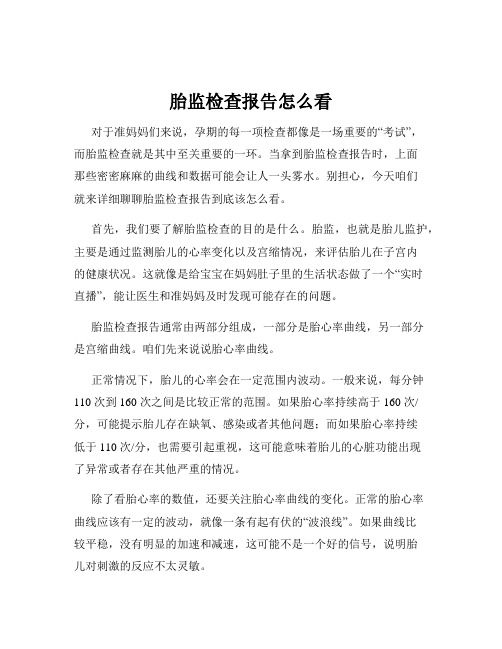
胎监检查报告怎么看对于准妈妈们来说,孕期的每一项检查都像是一场重要的“考试”,而胎监检查就是其中至关重要的一环。
当拿到胎监检查报告时,上面那些密密麻麻的曲线和数据可能会让人一头雾水。
别担心,今天咱们就来详细聊聊胎监检查报告到底该怎么看。
首先,我们要了解胎监检查的目的是什么。
胎监,也就是胎儿监护,主要是通过监测胎儿的心率变化以及宫缩情况,来评估胎儿在子宫内的健康状况。
这就像是给宝宝在妈妈肚子里的生活状态做了一个“实时直播”,能让医生和准妈妈及时发现可能存在的问题。
胎监检查报告通常由两部分组成,一部分是胎心率曲线,另一部分是宫缩曲线。
咱们先来说说胎心率曲线。
正常情况下,胎儿的心率会在一定范围内波动。
一般来说,每分钟110 次到 160 次之间是比较正常的范围。
如果胎心率持续高于 160 次/分,可能提示胎儿存在缺氧、感染或者其他问题;而如果胎心率持续低于 110 次/分,也需要引起重视,这可能意味着胎儿的心脏功能出现了异常或者存在其他严重的情况。
除了看胎心率的数值,还要关注胎心率曲线的变化。
正常的胎心率曲线应该有一定的波动,就像一条有起有伏的“波浪线”。
如果曲线比较平稳,没有明显的加速和减速,这可能不是一个好的信号,说明胎儿对刺激的反应不太灵敏。
胎心率加速是一个很重要的指标。
当胎儿受到刺激,比如妈妈的活动、声音或者触摸腹部时,胎心率会出现短暂的加快,这通常表示胎儿的神经系统发育良好,有足够的储备能力来应对外界的变化。
相反,如果胎心率减速,特别是反复出现的减速,就可能提示胎儿存在缺氧等危险情况。
接下来,咱们再看看宫缩曲线。
宫缩曲线可以反映出妈妈子宫收缩的强度和频率。
在孕晚期,偶尔出现一些轻微的宫缩是正常的,但如果宫缩过于频繁或者强度过大,就可能会导致早产等问题。
在胎监报告中,还会有一些评分指标,比如 NST 评分(无应激试验评分)和 CST 评分(宫缩应激试验评分)。
NST 评分主要根据胎心率的变化、加速次数等因素来打分,一般8 分以上表示胎儿状况良好;而 CST 评分则综合考虑宫缩时胎心率的变化,来判断胎儿能否耐受宫缩带来的压力。
产时胎儿监护指南解读
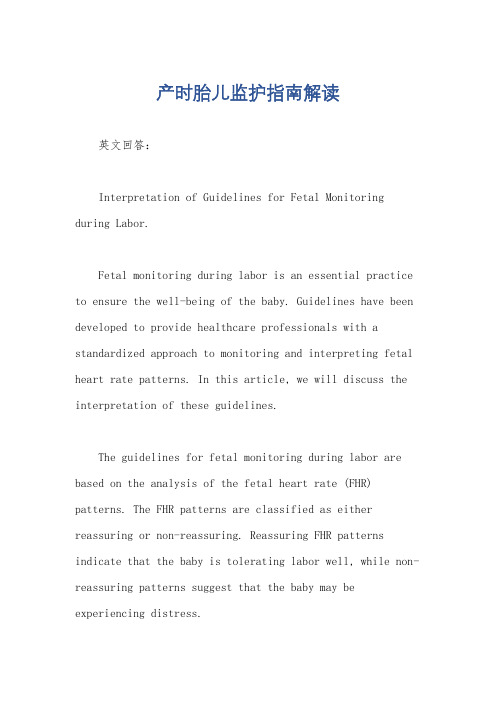
产时胎儿监护指南解读英文回答:Interpretation of Guidelines for Fetal Monitoring during Labor.Fetal monitoring during labor is an essential practice to ensure the well-being of the baby. Guidelines have been developed to provide healthcare professionals with a standardized approach to monitoring and interpreting fetal heart rate patterns. In this article, we will discuss the interpretation of these guidelines.The guidelines for fetal monitoring during labor are based on the analysis of the fetal heart rate (FHR) patterns. The FHR patterns are classified as either reassuring or non-reassuring. Reassuring FHR patterns indicate that the baby is tolerating labor well, while non-reassuring patterns suggest that the baby may be experiencing distress.Reassuring FHR patterns include a baseline heart rateof 110-160 beats per minute (bpm) with moderate variability. The baseline is the average FHR during a 10-minute period, excluding periodic or episodic changes. Moderatevariability indicates fluctuations in the FHR of 6-25 bpm. Absence of late or variable decelerations, and the presence of accelerations, are also indicators of a reassuring FHR pattern.Non-reassuring FHR patterns include bradycardia (baseline heart rate less than 110 bpm), tachycardia (baseline heart rate greater than 160 bpm), absent or minimal variability, late decelerations, variable decelerations, and prolonged decelerations. These patterns may suggest fetal distress and require further evaluation and intervention.When interpreting FHR patterns, healthcareprofessionals should consider the clinical context,maternal-fetal risk factors, and the presence of othersigns of fetal well-being. Continuous monitoring anddocumentation of the FHR patterns are crucial for accurate interpretation.In cases of non-reassuring FHR patterns, interventions such as changing maternal position, administering oxygen to the mother, and increasing intravenous fluids may be implemented. If the non-reassuring pattern persists or worsens, further interventions such as fetal scalp stimulation, fetal blood sampling, or expedited delivery may be necessary.In conclusion, the guidelines for fetal monitoring during labor provide healthcare professionals with a standardized approach to interpreting FHR patterns. Reassuring patterns indicate that the baby is tolerating labor well, while non-reassuring patterns suggest the possibility of fetal distress. Continuous monitoring, accurate interpretation, and appropriate interventions are essential for ensuring the well-being of the baby during labor.中文回答:产时胎儿监护指南解读。
胎监报告怎么看
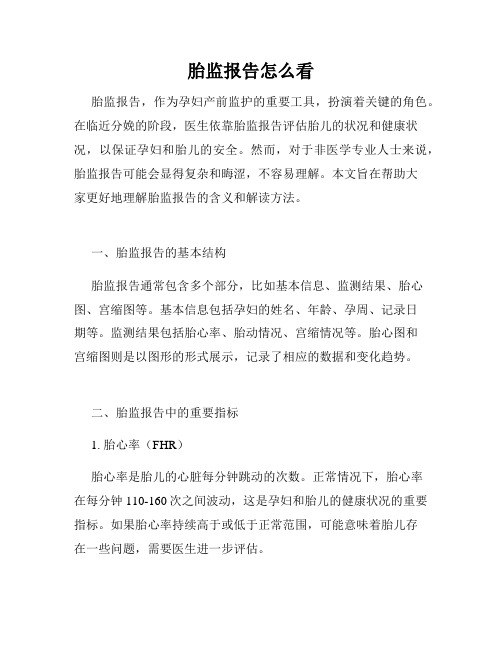
胎监报告怎么看胎监报告,作为孕妇产前监护的重要工具,扮演着关键的角色。
在临近分娩的阶段,医生依靠胎监报告评估胎儿的状况和健康状况,以保证孕妇和胎儿的安全。
然而,对于非医学专业人士来说,胎监报告可能会显得复杂和晦涩,不容易理解。
本文旨在帮助大家更好地理解胎监报告的含义和解读方法。
一、胎监报告的基本结构胎监报告通常包含多个部分,比如基本信息、监测结果、胎心图、宫缩图等。
基本信息包括孕妇的姓名、年龄、孕周、记录日期等。
监测结果包括胎心率、胎动情况、宫缩情况等。
胎心图和宫缩图则是以图形的形式展示,记录了相应的数据和变化趋势。
二、胎监报告中的重要指标1. 胎心率(FHR)胎心率是胎儿的心脏每分钟跳动的次数。
正常情况下,胎心率在每分钟110-160次之间波动,这是孕妇和胎儿的健康状况的重要指标。
如果胎心率持续高于或低于正常范围,可能意味着胎儿存在一些问题,需要医生进一步评估。
2. 胎动(FM)胎动是指胎儿在子宫内的运动。
胎动次数和强度对于评估胎儿的健康状况非常重要。
正常情况下,胎儿每天应该有一定的胎动次数,如果孕妇感觉到胎动明显减少或消失,可能需要及时就医。
3. 宫缩(UC)宫缩是指子宫肌肉的收缩。
宫缩图会记录宫缩的频率、持续时间和强度。
在产前期,宫缩的活动是正常的,但如果宫缩过于频繁或太强烈,可能会导致早产或其他并发症。
三、如何解读胎监报告1. 观察胎心率的变化趋势:正常胎心率应该稳定在110-160次/分钟,但在活动或其他刺激下,胎心率可能会有短暂的增加。
如果胎心率持续升高或降低,可能表示胎儿存在一些问题,如缺氧等。
2. 注意胎心率的变异性:胎心率的变异性指的是胎心率波动的幅度。
正常情况下,胎心率应该有一定的波动,这是胎儿神经系统和心脏功能发育良好的表现。
如果胎心率变异性较低,可能需要进一步检查。
3. 注重胎动的次数和质量:胎动的减少或消失可能会提示胎儿健康状况存在问题。
如果孕妇感觉到胎动的明显减少或没有胎动,应及时咨询医生。
产前胎儿监护实践指南(2021年版)解读
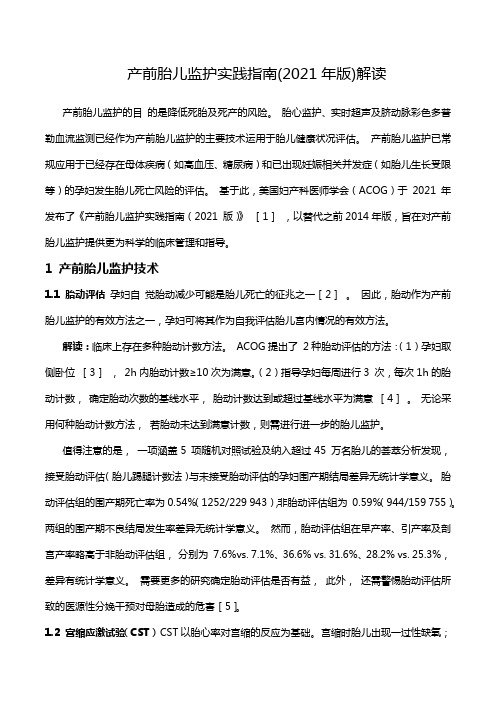
产前胎儿监护实践指南(2021年版)解读产前胎儿监护的目的是降低死胎及死产的风险。
胎心监护、实时超声及脐动脉彩色多普勒血流监测已经作为产前胎儿监护的主要技术运用于胎儿健康状况评估。
产前胎儿监护已常规应用于已经存在母体疾病(如高血压、糖尿病)和已出现妊娠相关并发症(如胎儿生长受限等)的孕妇发生胎儿死亡风险的评估。
基于此,美国妇产科医师学会(ACOG)于2021 年发布了《产前胎儿监护实践指南(2021 版)》[1],以替代之前2014年版,旨在对产前胎儿监护提供更为科学的临床管理和指导。
1 产前胎儿监护技术1.1胎动评估孕妇自觉胎动减少可能是胎儿死亡的征兆之一[2]。
因此,胎动作为产前胎儿监护的有效方法之一,孕妇可将其作为自我评估胎儿宫内情况的有效方法。
解读:临床上存在多种胎动计数方法。
ACOG提出了2种胎动评估的方法:(1)孕妇取侧卧位[3],2h内胎动计数≥10次为满意。
(2)指导孕妇每周进行3 次,每次1h的胎动计数,确定胎动次数的基线水平,胎动计数达到或超过基线水平为满意[4]。
无论采用何种胎动计数方法,若胎动未达到满意计数,则需进行进一步的胎儿监护。
值得注意的是,一项涵盖5 项随机对照试验及纳入超过45 万名胎儿的荟萃分析发现,接受胎动评估(胎儿踢腿计数法)与未接受胎动评估的孕妇围产期结局差异无统计学意义。
胎动评估组的围产期死亡率为0.54%(1252/229 943),非胎动评估组为0.59%(944/159 755)。
两组的围产期不良结局发生率差异无统计学意义。
然而,胎动评估组在早产率、引产率及剖宫产率略高于非胎动评估组,分别为7.6%vs. 7.1%、36.6% vs. 31.6%、28.2% vs. 25.3%,差异有统计学意义。
需要更多的研究确定胎动评估是否有益,此外,还需警惕胎动评估所致的医源性分娩干预对母胎造成的危害[5]。
1.2 宫缩应激试验(CST)CST以胎心率对宫缩的反应为基础。
胎心监护的解读

胎儿心动过速的评估与处理:产时胎心率基线>160次/分并持续至少10分钟以上称之为胎儿心动过速。 需要查找导致胎心过速的原因,常见的原因有感染、药物、母亲合并症(如甲亢),
胎儿心动过缓和延长减速的评估与处理:胎心率基线<110次/分并持续至少10分钟以上称之为胎儿心 动过缓。虽然产前的胎心动过缓往往与胎儿先天性心脏疾患有关低产时出现的胎儿心动过缓则多是 突发事件。与心脏发育异常无明显关系。
显著变异
加速
加速(acceleration)指基线胎心率突然显著增加,开始到波峰时间 <30秒。从胎心率开始加速至恢复到基线胎心率水平的时间为加 速时间。
孕32周及以上的胎心加速标准:胎心加速≥15次1分持续时间>15秒, 但不超过2分钟; 孕32周以下的胎心加速标准:胎心加速≥10次/分、持续时间>10秒, 但不超过2分钟。 延长加速;胎心加速持续2~10分钟。胎心加速≥10分钟则考虑胎心 率基线变化。
(5)短变异:指每一次胎心搏动至下一次胎心搏动瞬时的胎心率改变,即每一搏胎 心率数值与下一搏胎心率数值之差,这种变异估测的是2次心脏收缩时间的间隔。
(6)长变异:指1分钟内胎心率基线肉眼可见的上下摆动的波形,此波形由振幅和频 率组成。振幅是波形上下摆动的高度,以“次/分”显示,频率指1分钟内肉眼可见的 波动的频数,以“周期/分”表示,正常波形的频率为3~5周期/分。
胎心监护图评分解读,了解胎儿健康状态
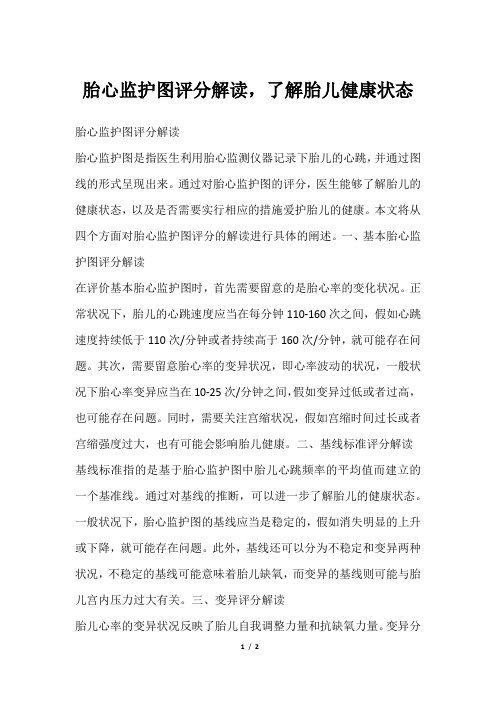
胎心监护图评分解读,了解胎儿健康状态胎心监护图评分解读胎心监护图是指医生利用胎心监测仪器记录下胎儿的心跳,并通过图线的形式呈现出来。
通过对胎心监护图的评分,医生能够了解胎儿的健康状态,以及是否需要实行相应的措施爱护胎儿的健康。
本文将从四个方面对胎心监护图评分的解读进行具体的阐述。
一、基本胎心监护图评分解读在评价基本胎心监护图时,首先需要留意的是胎心率的变化状况。
正常状况下,胎儿的心跳速度应当在每分钟110-160次之间,假如心跳速度持续低于110次/分钟或者持续高于160次/分钟,就可能存在问题。
其次,需要留意胎心率的变异状况,即心率波动的状况,一般状况下胎心率变异应当在10-25次/分钟之间,假如变异过低或者过高,也可能存在问题。
同时,需要关注宫缩状况,假如宫缩时间过长或者宫缩强度过大,也有可能会影响胎儿健康。
二、基线标准评分解读基线标准指的是基于胎心监护图中胎儿心跳频率的平均值而建立的一个基准线。
通过对基线的推断,可以进一步了解胎儿的健康状态。
一般状况下,胎心监护图的基线应当是稳定的,假如消失明显的上升或下降,就可能存在问题。
此外,基线还可以分为不稳定和变异两种状况,不稳定的基线可能意味着胎儿缺氧,而变异的基线则可能与胎儿宫内压力过大有关。
三、变异评分解读胎儿心率的变异状况反映了胎儿自我调整力量和抗缺氧力量。
变异分为三种类型,即周期性变异、非周期性变异和缺乏变异。
周期性变异表明胎儿有良好的自我调整力量,可以快速适应外部环境的变化;而非周期性变异则可能与胎儿缺氧有关,缺乏变异则是胎儿自我调整力量较差的表现。
四、胎压评分解读胎压指的是胎儿在子宫内部所承受的压力,是评价胎儿健康状况的重要指标之一。
正常状况下,胎儿可以通过身体的自我调整来适应肯定的压力,但是假如压力过大或过长时间持续,就可能对胎儿产生负面影响。
评估胎压需要留意胎盘相关指标和宫内压力指标,如胎盘位置、胎盘成熟度、宫内压力、羊水指标等。
胎心监护报告怎么看

胎心监护报告怎么看胎心监护报告是在产妇分娩过程中,用于记录胎儿胎心情况的一项重要检查。
通过监测胎儿的心率,可以了解胎儿的生命体征和胎儿在子宫内的状况。
下面将从胎儿胎心基本情况、监测指标、评价标准和异常情况四个方面介绍如何解读胎心监护报告。
胎儿胎心基本情况:报告中会有胎儿胎心基本情况的记录,包括胎心基线、胎心变异、胎动次数、胎儿运动情况等。
胎心基线指的是胎儿静息时的正常心率水平,一般在110-160次/分钟之间。
胎心变异是指胎心率相对于基线的变化情况,它反映了胎儿的自主调节能力。
胎动次数表示胎儿在一定时间内的活动次数,活动次数越多,说明胎儿状态越好。
胎儿运动情况是指胎儿在监测过程中的运动状况,如主动运动、反应运动等。
监测指标:胎心监护报告还会显示一些重要的监测指标,如加速、减速、宫缩等。
加速是指胎心率在短时间内明显增加,一般是正常胎状的表现。
减速是指胎心率在短时间内明显降低,可能是胎儿受到一些不良刺激导致的。
宫缩是指子宫收缩,一般用弧形线表示,宫缩可影响胎儿胎心情况。
评价标准:根据监护报告中胎心的变化情况,可以进行评价和判断。
评价标准通常包括胎心基线、变异、加速以及减速等指标。
正常情况下,胎心应该保持在基线范围内,并且变异应该较为均匀,加速应该有,减速应该较少。
如果发现胎心基线偏高或偏低、变异不均匀或缺乏加速等情况,可能需要进一步观察或采取相应的处理措施。
异常情况:如果胎心监护报告中出现异常情况,应引起重视。
常见的异常情况包括胎心减速、胎心过缓或过速、胎心爬升等。
胎心减速是指胎心率在宫缩期间明显降低,可能是由于宫缩造成了胎儿氧气供应不足。
胎心过缓或过速可能与胎儿心脏本身的问题有关。
胎心爬升是指胎心率在一段时间内持续上升,可能是胎儿受到强烈刺激或其他原因导致。
综上所述,胎心监护报告是分娩过程中重要的监测手段,通过分析报告中的胎儿胎心情况、监测指标、评价标准和异常情况等,可以判断胎儿的状态和胎心状况。
如何看胎心监护图报告
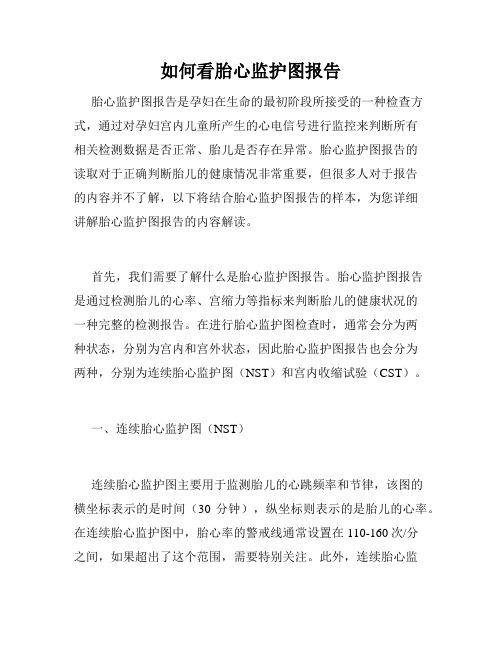
如何看胎心监护图报告胎心监护图报告是孕妇在生命的最初阶段所接受的一种检查方式,通过对孕妇宫内儿童所产生的心电信号进行监控来判断所有相关检测数据是否正常、胎儿是否存在异常。
胎心监护图报告的读取对于正确判断胎儿的健康情况非常重要,但很多人对于报告的内容并不了解,以下将结合胎心监护图报告的样本,为您详细讲解胎心监护图报告的内容解读。
首先,我们需要了解什么是胎心监护图报告。
胎心监护图报告是通过检测胎儿的心率、宫缩力等指标来判断胎儿的健康状况的一种完整的检测报告。
在进行胎心监护图检查时,通常会分为两种状态,分别为宫内和宫外状态,因此胎心监护图报告也会分为两种,分别为连续胎心监护图(NST)和宫内收缩试验(CST)。
一、连续胎心监护图(NST)连续胎心监护图主要用于监测胎儿的心跳频率和节律,该图的横坐标表示的是时间(30分钟),纵坐标则表示的是胎儿的心率。
在连续胎心监护图中,胎心率的警戒线通常设置在110-160次/分之间,如果超出了这个范围,需要特别关注。
此外,连续胎心监护图中也会出现所谓的“变异”,最好是出现浅而广的变异,显然胎宝宝一直维持在某一频率时也会引起关注。
二、宫内收缩试验(CST)宫内收缩试验适用于监测所谓的“面临高危妊娠”的妇女,该图的横坐标表示的是时间(40分钟),纵坐标则表示的是胎儿的心率和宫缩力度。
在宫内收缩试验中,小于等于3次的宫缩试验被视为正常,但如果超出了3次,则需要特别关注。
此外,宫内收缩试验中还需要关注的是所谓的“延迟反应时间”。
以上是胎心监护图报告的内容简要说明,如果生活中你遇到了胎心监护图报告需要解读,希望上述内容对你有所帮助。
总之,无论您是否怀孕,对于胎心监护图报告的正确判断和解读都是生活中重要的一步。
胎儿监护PPT课件

目录
• 引言 • 胎儿监护的基本知识 • 胎儿监护的临床应用 • 胎儿监护的注意事项 • 胎儿监护的未来发展 • 结论
01
引言
胎儿监护的重要性
保障母婴安全
通过胎儿监护,可以及时发现胎 儿宫内异常情况,采取相应措施,
降低新生儿死亡率,保障母婴安 全。
提高产科质量
胎儿监护是产科质量的重要指标之 一,通过监护可以评估胎儿和胎盘 状况,为临床医生提供决策依据, 提高产科质量。
02
胎儿监护是产前护理的重要组成 部分,有助于及时发现和处理胎 儿异常情况,降低围产期并发症 和死亡率。
胎儿监护的方法
01
02
03
04
胎心监测
通过电子设备监测胎儿心跳, 了解胎儿的心率、心律和胎动
情况。
生物物理监测
通过观察胎儿的呼吸运动、肌 肉活动、羊水情况等生物物理 指标,评估胎儿的健康状况。
超声检查
合理选择胎儿监护方式
根据实际情况选择合适的胎儿监护方 式,如胎心监测、胎动计数等,以达 到最佳的监测效果。
定期进行胎儿监护
定期进行胎儿监护有助于及时发现胎 儿的异常情况,采取相应的措施保障 母婴安全。
结合其他产前检查
胎儿监护只是产前检查的一部分,应 结合其他检查手段如B超、唐筛等, 全面评估胎儿的健康状况。
优势
提高诊断效率和准确性,降低 漏诊和误诊率。
挑战
数据质量和标注问题,人工智 能技术的可靠性和安全性需进
一步验证。
06
结论
胎儿监护的重要性和发展前景
胎儿监护的重要性
胎儿监护是一种监测胎儿健康状况的方法,通过胎心监测、胎动计数等手段,可 以及时发现胎儿的异常情况,保障母婴安全。随着医疗技术的不断发展,胎儿监 护已经成为产科领域的重要手段,对于保障母婴健康具有重要意义。
2022产时胎心监护判读及处理(全文)

2022产时胎心监护判读及处理(全文)胎儿监护方法的选择:间歇胎心听诊、胎心宫缩监护(持续胎心监测)、胎儿头皮乳酸评估、胎儿头皮PH值分析、胎儿脉搏血氧测定,以及胎儿ST 段分析等。
胎儿监护方法常用方法:间歇胎心听诊、胎心宫缩监护(持续胎心监测)。
01如何选择合适的胎儿监护方法A美国妇产科协会(ACOG)-对于无并发症的患者,可进行电子胎心监护或间歇胎心听诊。
-对于高危妊娠(如,子痫前期、疑似生长受限或1型糖尿病),临产过程中应连续电子胎心监护。
A英国国家卫生与保健评价研究员(NICE)•对于所有分娩病例,在第一产程对低危产妇进行间歇胎心听诊。
不对低危产妇进行电子胎心监护。
-在临产过程中,如果出现下列任何危险因素,建议进行电子胎心监护:-怀疑存在绒毛膜羊膜炎、脓毒症或体温不低于38℃-重度高血压(≥160∕i:LOmmHg)-使用缩宫素-有明显的胎粪-新鲜的阴道出血•如果由于间歇胎心听诊显示存在问题而进行电子胎心监护但观察20分钟后发现监护图形正常,可转为间歇胎心听诊。
02持续电子胎心监护A在产妇进入待产室后,电子胎心监护至少20-30分钟,并评估子宫活动和产妇的生命体征。
A在美国,对于初始胎心监护图形正常的低危妊娠,在患者没有走动、洗澡、频繁活动时行电子胎心监护,在第一产程活跃期至少每30分钟评估1次FHR,在第二产程至少每15分钟评估1次FHR oA对高危妊娠,在第一产程活跃期至少每15分钟评估1次FHR,在第二产程通常至少每5分钟评估1次FHR o03间歇性停诊(在美国,产时很少进行间歇胎心听诊)A目前没有比较间歇胎心听诊方案的试验,以下是常见做法:•低危妊娠:在第一产程活跃期,至少每30分钟在1次宫缩过程中及结束后即刻测定、评估并记录FHR;在第二产程至少每15分钟1次。
•如果存在高危因素,最好在第一产程活跃期,至少每15分钟在1次宫缩前、中和后测定、评估并记录FHR,在第二产程至少每5分钟1次。
胎儿监护报告怎么看

2020年1月第2期经验交流胎儿监护报告怎么看米雪遂宁市中心医院产科,四川 遂宁 629000[中图分类号]G280.1:R [文献标识码]A [文章编号]2096-5249(2020)02-0215-02胎儿监护室应用电子监护仪检测胎儿在宫内的情况,一般是在门诊部进行,检查时间约为20分钟,主要观察胎动、胎心和宫缩三者之间的关系,正常的胎心率基线是每分钟110~160次,胎动时胎心上升的持续时间大于15秒,检查每个数值是否处于正常范围之内。
下面给大家介绍一下胎儿监护报告应该怎么看。
1 胎心监护仪胎心监护仪主要有两个探头构成,探头的主要作用是获取胎心数据、胎动、了解宫缩强度,分为绑在子宫顶端或放在肚脐下方胎儿的胸部、背部位置,通过信号描记瞬间的胎心变化所形成胎心监护图,观察胎动以及宫缩时胎心的反应,判断胎儿是否存在缺氧现象。
如果胎儿心态过缓,则证明胎儿胎儿存在缺氧现象,如果过于严重需立即前往医院救治,必要时可提前结束妊娠。
但在监测的过程中也要注意,不要频繁检测胎心,因为此种方式会让孕妇增加心理负担,从而影响胎儿神经发育系统,长此以往就会导致宫内缺氧,对婴儿及其不利。
2 胎心监护的重要性胎儿正常的胎心会随着子宫内环境的不同,时刻有所变化,胎心率的变化表明胎儿在子宫内状态良好,也说明孕妇的各项身体机能正常。
主要是利用胎心听诊仪对胎心进行监测,监测效果良好,可有效显示胎心率,监测胎儿在母体内的状况,可及时发现胎儿异常,尽早采取医疗措施,减少胎儿身体的损伤。
3 如何看懂胎心监护图胎心监护图上有两条曲线,两条曲线的作用分别是记录宫缩情况、记录胎心率的变化,胎儿正常活动时胎心率会比休息时要快,并且持续时间相对较长,大约在15秒以内,表明胎儿正常。
如果胎心率过缓,或者没有胎动,证明胎儿异常,需要重复做一次检查,检查时间最佳时间为1小时后,也可以根据孕妇身体状况,做相应检查,找到胎心出现异常的原因,及时治疗。
具体可参考如下方法查看:3.1检查宫缩频率 检查宫缩频率,孕妇临产前正常的宫缩频率为每十分钟内在5次以内,检查需观察宫缩频率30分钟以上,观察子宫曲线,如果宫缩频率增加,表示子宫曲线减速,宫内压力增高,胎儿的心率也会逐渐变缓。
胎心监护解读培训课件

胎心监护解读
23
医生
助产士
1级 A:动态观察
A:动态观察
2级 A:动态观察
B:连续监测
B:加强监护、采取保守措施及 报告医生
查找原因
3级 B:加强监护、采取保守措施C:采取保守措施及查找原因, C:连续监护
做紧急终止妊娠准备
请医生到场
4级
C:采取保守措施及查找原因, C:连续监护
胎心监护解读
6
胎心监护的解读-基线变异的判读
小变异为变异幅度为5bpm以下 正常为中等变异, 变异幅度6-25bpm 显著变异为变异幅度大于26bpm 消失型为缺乏变异(变异缺失)肉眼几乎无法判
别
胎心监护解读
7
胎心监护的解读-加速的判读
妊娠≥32周,FHR较基线最大上升15bpm,持续>15 秒,但要<2分钟
早发 变减轻度 变减重度 晚减轻度 晚减重度 延长轻度 延长重度
与胎心
基线无 2 2 3 3 3 4 3 4
关
胎心监护解读
22
对策及处理
风险等级3.4级者,需每10分钟重新评估 在实施处理时,要考虑产妇的背景情况(孕周,
母亲合并症,胎儿有无异常,脐带、胎盘、羊水 有无异常,产程进展等)、动态变化及所在医疗 机构临床处理能力(紧急剖宫产准备时间)等
反复性减速-20分观察时间内≥50%的宫缩均伴发 减速
早减与晚减-在于减速发生时间、出现减速峰值时 间以及FHR恢复时间与宫缩的相互关系
间隙性减速-20分观察时间内﹤ 50%的宫缩均伴发 减速
胎心监护解读
9
胎心监护的解读-早期减速
特点: 开始减速到最低点时间≥30秒,减速开始、 最低点、恢复和宫缩的起始、峰值和结束同步
胎心监护报告怎么看
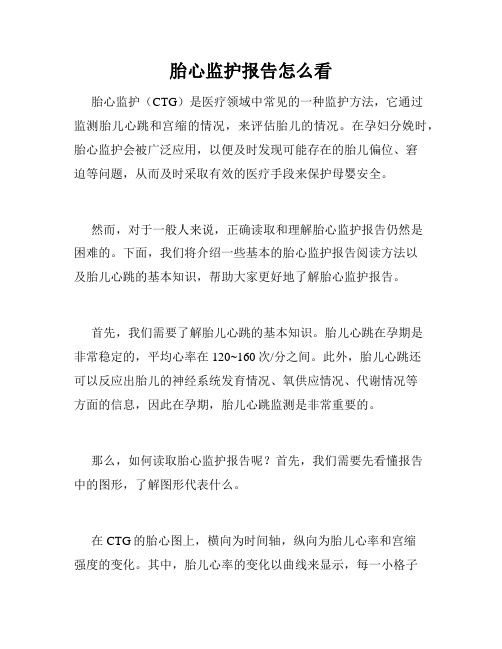
胎心监护报告怎么看胎心监护(CTG)是医疗领域中常见的一种监护方法,它通过监测胎儿心跳和宫缩的情况,来评估胎儿的情况。
在孕妇分娩时,胎心监护会被广泛应用,以便及时发现可能存在的胎儿偏位、窘迫等问题,从而及时采取有效的医疗手段来保护母婴安全。
然而,对于一般人来说,正确读取和理解胎心监护报告仍然是困难的。
下面,我们将介绍一些基本的胎心监护报告阅读方法以及胎儿心跳的基本知识,帮助大家更好地了解胎心监护报告。
首先,我们需要了解胎儿心跳的基本知识。
胎儿心跳在孕期是非常稳定的,平均心率在120~160次/分之间。
此外,胎儿心跳还可以反应出胎儿的神经系统发育情况、氧供应情况、代谢情况等方面的信息,因此在孕期,胎儿心跳监测是非常重要的。
那么,如何读取胎心监护报告呢?首先,我们需要先看懂报告中的图形,了解图形代表什么。
在CTG的胎心图上,横向为时间轴,纵向为胎儿心率和宫缩强度的变化。
其中,胎儿心率的变化以曲线来显示,每一小格子代表10秒,每一大格子代表1分钟。
在正常情况下,胎儿心跳的曲线会有阵发性的波动,这是正常的心率变异性。
若曲线变得单调平缓,可能意味着胎儿存在窘迫等问题。
另外,在胎心监护报告中,宫缩强度也非常重要。
宫缩曲线的图形显示了子宫肌肉的收缩情况,每一小格子代表10mmHg,根据图形我们可以判断宫缩的频率和强度。
读懂了图形之后,我们需要进一步阅读报告。
首先,注意报告中的胎儿心率。
正常情况下,胎儿心率0~4级变化是正常的,5级以上的持续变化则可能意味着胎儿窘迫。
如果持续时间超过10分钟,建议及时就医。
此外,如果曲线过于平缓、过于急促或过于崎岖等,也可能会给医生提供其他的重要信息。
另外,注意报告中的宫缩情况。
宫缩情况对胎儿心跳有着重要的影响。
如果宫缩次数较多、持续时间较长或强度较大,可能会导致胎儿心跳异常反应,所以在孕期一旦发现了异常宫缩,应该及时就诊。
最后,需要强调的是,胎心监护报告只是一种辅助诊断工具,不能作为最终的诊断结果。
怎么看胎心监护报告单

怎么看胎心监护报告单怀孕对于每个准妈妈来说都是一段激动而又忐忑的旅程。
在整个孕期中,胎宝宝的健康状况一直是准妈妈们最为关心的事情之一。
而胎心监护,作为一种常见的监测手段,可以帮助妈妈们了解胎儿的心跳情况,从而判断胎宝宝是否健康。
然而,对于大部分妈妈来说,胎心监护报告单却常常让人感到头疼。
那么,我们就来看看如何正确读懂胎心监护的报告单。
首先,我们需要了解胎心监护报告单的基本结构和内容。
一份典型的胎心监护报告单通常由四个主要部分构成:基本信息、监护曲线、评估结果和医生意见。
在基本信息部分,你会找到有关妈妈和胎宝宝的一些基本信息,例如妈妈的姓名、年龄、以及孕周数等等。
这些信息有助于医生对胎儿的监护提供更准确的参考。
接下来,是监护曲线部分。
这是整张报告单最重要的部分,也是最关键的“秘密”所在。
通常,这个部分会展示出两条曲线,一条是宫缩曲线,另一条则是胎心曲线。
宫缩曲线显示的是子宫收缩的频率和持续时间,而胎心曲线则反映了胎宝宝的心跳情况。
胎心曲线是我们最为关注的部分。
一条正常的胎心曲线应该呈现出周期性的波动,即快而有力的跳动之后,有一个短暂的平静期,然后再次开始快速而有力地跳动。
这种节奏和幅度的变化显示了胎儿的心脏和神经系统的正常发育。
如果发现胎心曲线呈现出不规则的波动,或者跳动的幅度过小或过大,那么就可能意味着胎宝宝存在一些问题。
接下来是评估结果部分,这个部分会对监护曲线进行评估,并给出一个相应的结论。
通常有三个评估结果,即正常、可疑和异常。
如果胎心曲线呈现出正常的波动,宫缩也在正常范围内,那么评估结果就会被认定为“正常”。
如果监护曲线有一些轻微的异常,但并无严重问题,那么评估结果可能会被标记为“可疑”。
而如果胎心曲线有重大异常,或者宫缩异常,那么评估结果就会是“异常”。
最后,是医生意见部分。
在这个部分,医生会根据监护曲线的情况,给出一些建议和建议。
这些建议可能包括进一步检查,例如进行胎儿超声检查或血液检查,以确认胎儿的健康状况。
胎心监护报告单怎么看

胎心监护报告单怎么看胎心监护报告单是妇产科医生用来监测胎儿健康状况的一种重要工具。
它记录了胎儿心率和宫缩情况等关键指标,是评估胎儿是否处于正常状态的重要依据。
然而,对于普通人来说,胎心监护报告单上的各种曲线和数字可能会让人不知所措。
那么,我们该如何正确地解读胎心监护报告单呢?让我们一起来了解一下。
首先,让我们了解一下报告单上常见的几个关键指标。
胎心率是胎儿心脏每分钟跳动的次数,通常以bpm来表示,即beats per minute。
胎心率是报告单上最直观的指标之一,也是评估胎儿是否处于正常状态的重要依据。
一般而言,胎心率在110-160 bpm之间被认为是正常的范围。
接下来,让我们看一下报告单上的胎心率变异。
胎心率变异指的是胎儿心率在一定时间内的波动情况。
正常的胎儿心率应该具有一定的变异性,这表明胎儿的自主调节能力良好。
一般来说,胎儿心率变异较大是一个良好的指标,而变异较小可能代表胎儿未来的问题。
因此,当我们看到报告单上的胎心率变异较大时,可以认为胎儿处于正常状态。
报告单上还有一个重要的指标是宫缩情况。
宫缩是指子宫肌肉的收缩,通常会伴随着频率和持续时间的变化。
在报告单上,宫缩一般以曲线的形式显示。
我们可以通过观察曲线的高低和波动情况来判断宫缩的强度和频率。
正常情况下,宫缩应该具有一定的规律性和节奏性。
如果宫缩过于频繁或过于强烈,可能会对胎儿造成不利影响。
因此,妇产科医生会关注报告单上的宫缩情况,以评估胎儿的安全状况。
除了以上几个常见指标外,报告单上还可能会包含其他的信息,比如胎动情况、剖宫产指征等。
这些信息都是对胎儿健康状况的评估和判断的重要依据。
要正确解读胎心监护报告单,我们要根据个体情况进行综合判断。
譬如,孕妇的年龄、孕周、孕妇有无合并症等都会影响到对胎儿健康的评估。
因此,如果对报告单上的指标有疑问,最好咨询专业的医生进行解读。
总的来说,胎心监护报告单是评估胎儿健康状况的重要工具,了解其中的关键指标和正常范围是正确解读的前提。
胎心监护基本分析

CST评分
0
1
2
评分
基 线 率
<100>180
100-119161-180
120-180
摆动振幅
<5
5-9>30
10-20
摆动频率
<2
2-6
增 速
无
周期性
散在性
减 速
晚期变异+其他
变异
无
宫缩情况
禁忌症:① 妊娠晚期出血② 既往剖宫产史③ 多胎妊娠④ 羊水过少或过多⑤ 先兆早产及宫颈松弛症⑥ 产道及胎位异常者⑦ NST评分低于6分
结 果 判 断
基 线
周期性特征
1、安 全
变异性良好稳定基线率
无减速早期减速中期变异性减速非正式加速
2、可疑宫内窘迫
心动过速(>160bpm)心动过缓(<120bpm)
无加速
3、宫内窘迫
基线率升高变异减弱
晚期减速变异性减速
4、严重宫内窘迫
变异消失基线不稳定心动过缓心动过速>180bpm
变异减速(VD)
轻度变异减速
重度变异减速
轻度变异减速
提示隐匿性脐带受压,羊水过少、颈绕颈或脐带过短如果过深(60bpm)或延长超过60s,提示严重窒息
明确病因,变换体位,吸氧,考虑分娩
处 理
子宫收缩开始后一段时间(多在高峰后)出现胎心率减慢下降缓慢,下降幅度<50bpm,持续时间长,恢复亦缓慢。 轻 度:下降 < 15bpm 中 度: 下降 15~45bpm 重 度: 下降 > 45bpm胎儿缺氧的表现,它的出现提示应对胎儿的安危予以高度注意。
使用度冷丁或吗啡 母婴出血和胎儿严重贫血 一过性的是良性的 延长或有压迫迹象,提示胎儿缺氧 检查母婴出血情况 如果持续,考虑分娩
胎心监护报告怎么看

胎心监护报告怎么看胎心监护报告是孕妇在怀孕期间常常会接受的一项检查,通过监测胎儿的心率,能够提供重要的信息,对胎儿的健康状况进行判断。
然而,对于非医学专业的人来说,胎心监护报告可能会显得晦涩难懂。
在本文中,我们将探讨一下如何正确地阅读和解读胎心监护报告。
首先,我们需要了解胎心监护报告的基本结构。
一份完整的胎心监护报告通常包含三个主要部分:基础信息、胎心监护图和医生的注释。
基础信息部分包括孕妇的姓名、年龄、孕周、孕次以及检查日期等。
这些基础信息对于医生进行后续的分析非常重要。
胎心监护图是胎心监护报告的核心部分,它通过曲线图的形式展示了胎儿的心率变化情况。
图中通常有两条曲线,一条表示胎儿的心率,另一条则表示宫缩的强度。
读取胎儿心率曲线时,我们需要注意以下几点。
首先,了解正常的胎心率范围是非常重要的。
胎心率通常在110到160次/分钟之间波动。
如果胎心率超出这个范围,可能意味着胎儿存在一些问题,需要引起重视。
当然,我们不能仅仅依靠一次监测结果就做出结论,需要结合其他检查和医生的意见。
其次,观察胎心率的变化趋势也是非常重要的。
正常情况下,胎儿的心率会有一定的变化,呈现出波动的形态。
这种变化趋势反映了胎儿的自主调节能力和胎盘供氧情况。
一份良好的胎心监护报告中,胎心率曲线应该呈现出稳定的变化和适当的波动,而不是持续的高低波动或者出现明显的不规则。
此外,胎心率的基线也是我们需要关注的内容之一。
基线是胎心率曲线在一个相对平稳的状态下所呈现的水平线。
正常情况下,基线应该保持稳定且处于110到160次/分钟之间。
如果基线偏离正常范围,可能说明胎儿存在某种异常情况,需要及时咨询医生。
最后,胎心监护报告还会附带医生的注释,他们会对监测结果进行解读和评估。
我们应该仔细阅读医生的意见,理解专业术语和解读结果,如果有任何疑问或者不明白的地方,可以主动向医生提问,获得更详细和准确的解答。
总而言之,正确阅读和解读胎心监护报告对于保障胎儿的健康至关重要。
产时胎儿监护
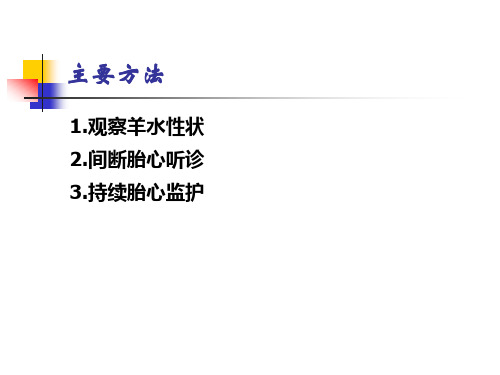
评分3-10/1-5
如何判断胎心监护是否异常
Dellinger 等(2000)分析了898例产时胎心监护, 根据分娩前1小时的胎心监护图形分为三个类型: “normal,” “stress,” or “distress”。 Fetal 发生率 1%, 其中70%“normal”,1% “distress”,只 有不到1/3为“srtess”。这个分型系统与围产期结局 如剖宫产、胎儿酸中毒、入住NICU的发生率有明显 相关性。2008年NICHD、SOGC采用上述胎心监护 分级管理系统。具体分为三级:正常、不确定、异常。
生儿的口咽部和鼻咽部,并不能预防和改变MAS的 进程。2007年美国儿科学会、2009年加拿大妇产科 学会指南都认为不必对经胎粪污染羊水娩出的新生儿 常规吸引。但是国内2011年新生儿复苏指南的建议 为:肩娩出前助产者用手挤出新生儿口、咽、鼻中的 分泌物,娩出后,用吸球或吸管清理分泌物,先口咽 后鼻腔。避免过度吸引导致的喉痉挛和迷走神经性心 动过缓。
早期减速
晚期减速
1、FHR通常表现为对称的、均 1、FHR通常表现为对称的、均 匀的减速和恢复,与宫缩相关联 匀的减速和恢复,与宫缩相关联
2、FHR的逐渐减速指从FHR出 现减速到最低点≥30s
3、减速最低点与宫缩的峰值同 时出现
4、减速起始点、最低点以及减 速的恢复分别与宫缩的开始、峰 值、结束同时发生。
40 不典型的变异减速-前后加速超限
200 160
120 80
40
不典型的变异减速-缺乏后加速
200 160
120
80
40
40
不典型的变异减速-后基线低限
不典型的变异减速-后基线超限
200 160 120 80 40
电脑胎儿监护分析报告单怎么看
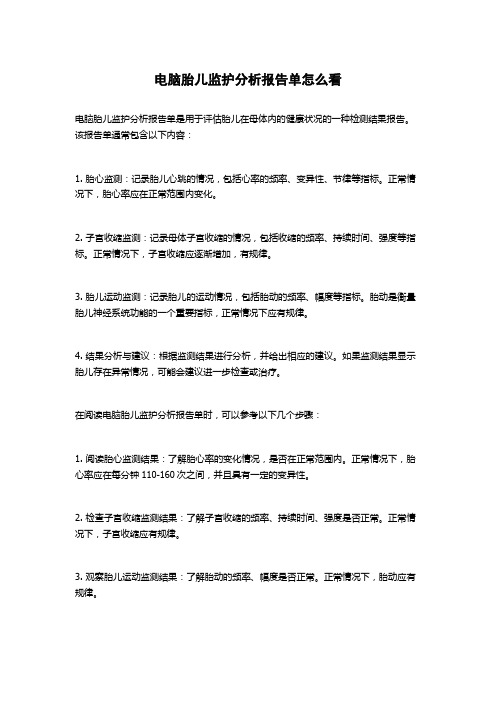
电脑胎儿监护分析报告单怎么看
电脑胎儿监护分析报告单是用于评估胎儿在母体内的健康状况的一种检测结果报告。
该报告单通常包含以下内容:
1. 胎心监测:记录胎儿心跳的情况,包括心率的频率、变异性、节律等指标。
正常情况下,胎心率应在正常范围内变化。
2. 子宫收缩监测:记录母体子宫收缩的情况,包括收缩的频率、持续时间、强度等指标。
正常情况下,子宫收缩应逐渐增加,有规律。
3. 胎儿运动监测:记录胎儿的运动情况,包括胎动的频率、幅度等指标。
胎动是衡量胎儿神经系统功能的一个重要指标,正常情况下应有规律。
4. 结果分析与建议:根据监测结果进行分析,并给出相应的建议。
如果监测结果显示胎儿存在异常情况,可能会建议进一步检查或治疗。
在阅读电脑胎儿监护分析报告单时,可以参考以下几个步骤:
1. 阅读胎心监测结果:了解胎心率的变化情况,是否在正常范围内。
正常情况下,胎心率应在每分钟110-160次之间,并且具有一定的变异性。
2. 检查子宫收缩监测结果:了解子宫收缩的频率、持续时间、强度是否正常。
正常情况下,子宫收缩应有规律。
3. 观察胎儿运动监测结果:了解胎动的频率、幅度是否正常。
正常情况下,胎动应有规律。
4. 阅读结果分析与建议:看看报告单是否有异常的结果或建议,如有需要可以向医生
或专业人士咨询。
需要注意的是,电脑胎儿监护分析报告单只是一项评估方法,不代表最终的诊断结果。
如有任何疑问或担忧,建议及时咨询医生或专业人士。
- 1、下载文档前请自行甄别文档内容的完整性,平台不提供额外的编辑、内容补充、找答案等附加服务。
- 2、"仅部分预览"的文档,不可在线预览部分如存在完整性等问题,可反馈申请退款(可完整预览的文档不适用该条件!)。
- 3、如文档侵犯您的权益,请联系客服反馈,我们会尽快为您处理(人工客服工作时间:9:00-18:30)。
by external Doppler ultrasound (US) with autocorrelation by fetal electrode (ECG)
Twin monitoring Maternal heart rate Event marker External tocography Mode, date and time printout Automatic maternal blood pressure pulse and SaO2 facility
胎儿心率的发育
The fetal heart is detectable by transvaginal US as early as 4 weeks after conception At this stage the mean FHR is about 100 bpm. Thereafter it progressively rises, reaching a mean of about 140-150 by 10 weeks menstrual age (8 weeks post conception), and levels off at that rate by the start of the second trimester. From 14 weeks to term there is a progressive fall in the mean baseline FHR which is unaffected by whether the fetus is Active or Quiescent This lowering of the baseline rate with gestation is a reflection of the fact that the sympathetic autonomic
胎儿产时缺氧
IP fetal hypoxia occurs in about 1% of labours. It can lead to one of three adverse outcomes:
Perinatal death (stillbirths and neonatal deaths)
• 胎儿不存在宫内缺氧
• 胎头受压 • 胎儿缺氧:第一产程早期的早减 • 胎儿缺氧
• 无脑儿等
• 脐带受压
• 胎儿缺氧:非典型变异减速 • 胎儿缺氧
胎监的三级诊断
分级 定义 评价 处理
Ⅰ
同时满足以下条件: 基线:110-~160bpm 基线变异:中度 晚期或变异减速:无 早期减速:有或无 加速:有或无
宫缩过频或过强 脐带、胎头受压 • 停用催产素 • 阴道检查
脐带受压
母亲因素 吸氧 宫缩频密
• 改变体位
• 血压监测、血氧 • 常用、但安全性及有效性待证实 • 宫缩抑制剂的应用
脐带受压
• 羊膜腔灌注
Cerebral palsy Hypoxic ischemic encephalopathy (HIE)
胎儿缺氧的机制与结局
Hypoxia may present chronically or acutely.
Chronic hypoxia evolves through a series of sequential
产时电子胎儿监护
主要内容
胎监应用的历史
应用胎监来筛查产时胎儿缺氧的发展现状
产时缺氧对胎儿及新生儿预后的关系
胎心率与胎儿的生物物理活动的关系
产时缺氧的EFM(Electronic Fetal Monitoring)
胎儿监护的发展
fetal monitors today have the following features: Reliable, provided they are regularly maintained and serviced User friendly with operating manual and video/DVD FHR recording:
基线
无宫缩---NST
变异
有规律宫缩 ---CST ---OCT
宫缩 加速 减速
胎儿电子监护的判读
• 胎监图形的各个基本指标的概念、
• 客观评价标准、临床意义
• 胎监图形的结果评价
• 结果如何指导临床的处理
胎监的临床意义
图形
判读
评价
如何
处理
各个指标的临床意义 胎心加速
早期减速 晚期减速 变异减速 正弦曲线
The patency of the umbilical cord
胎心减速
From 26 weeks onwards decelerations of the fetal heart should be regarded as abnormal. However, fetal decelerations are a normal feature before 26 weeks
胎监的三级诊断
分级 定义 评 价 处理
立即评估,迅 速采取措施如 吸氧、侧卧、 停止刺激、处 理孕妇低血压 以及宫缩过频 引起的胎心改 变;如上述措 施均无效,应 立即终止妊娠
Ⅲ
满足以下条件之一: 胎心基线变异缺失伴下列情况之一: 反复出现的晚期减速 反复出现的变异减速 胎心过缓 正弦曲线
异 常
Ⅱ级和Ⅲ级胎心监护的宫内复苏方法
changes. Acute hypoxia also evolves through a
different series of sequential changes. However, both
routes eventually can lead to the common outcome
判读胎儿电子监护图形的基本 要点
正常
定期监护
胎监的三级诊断
分级 定义 评 价
可疑
处理
需进行评估, 持续监护和再 评估,必要时 行其它辅助检 查以确定胎儿 情况及实施宫 内复苏
Ⅱ
胎心监护未达Ⅰ和Ⅲ级标准,如 基线:胎心过缓但不伴变异缺失 胎心过速 基线变异:微小变异 变异缺失不伴反复出现的晚期 减速 显著变异 加速:刺激胎儿后仍缺失 周期性减速: 反复出现的变异减速伴微小变异或中度 变异 延长减速( >2min但<10min) 反复出现的晚期减速伴基线中度变异 非特异性的变异减速
